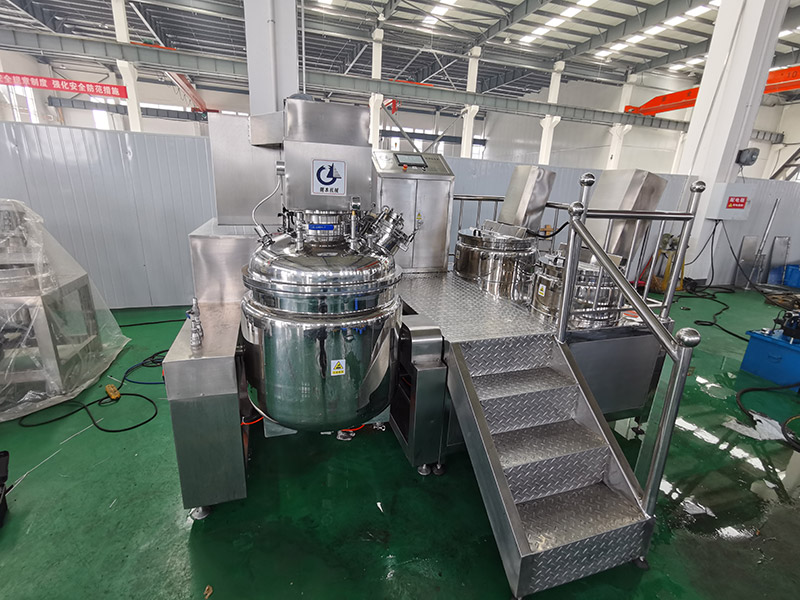Maximizing Efficiency in Food Processing: The Role of Vacuum Emulsification and Homogenization
Jiangsu GangBen Mixer Manufacturer specializes in packaging machinery research and development, design, manufacturing. In order to provide customers with better products and services, we always take the market demand as the driving force and basis for continuous innovation, and make solemn commitments to the market and society with professional technical design.In food processing, maximum efficiency is essential to ensure product safety, nutrition, taste and the sustainability of production. Among them, vacuum emulsification and homogenization technology play a key role in this process. The following explores in detail the role of these two technologies in improving the efficiency of food processing.
Emulsifying Homogenizer Mixer
Emulsifying Homogenizer Mixer technology is a process of emulsification and mixing under reduced pressure. In food processing, this technology is widely used to prepare emulsion, sauce, condiment and so on. The vacuum environment can effectively reduce oxygen contact and prevent oxidation reactions, thus maintaining the freshness and nutrients of food raw materials. In addition, vacuum emulsification can also improve the stability and fineness of the emulsion, so that it has a better taste and texture.
Advantages:
Reduce oxidation: In a vacuum environment, the low oxygen content significantly reduces the occurrence of oxidation reactions, which is conducive to maintaining the color, flavor and nutritional value of food.
Improved stability: By precisely controlling the emulsification conditions, smaller, more uniform emulsion particles can be obtained, thereby improving the physical stability and shelf life of the product.
Maintain flavor: reduce the damage of high temperature treatment on food flavor, maintain the original aroma and taste of food.
Homogenization technology
Homogenization technology through high-pressure shear, impact or ultrasonic, the particles in food, fat balls, etc., broken and evenly dispersed in the liquid, so as to improve the physical properties and taste of food. In food processing, homogenization is often used in the production of dairy products (such as milk, yogurt), sauces, juices and other products.

Advantages:
Improve texture: Through homogenization, the particles in the food are refined, making the product taste more delicate and smooth.
Improve stability: Homogenization can reduce the phenomenon of fat floating and precipitation, improve the physical stability of the product, and extend the shelf life.
Enhance nutritional value: Homogenization helps to evenly distribute nutrients and improve the absorption rate of nutrients.
Combined application
The combination of vacuum emulsification and homogenization technology can further improve the efficiency and quality of food processing. For example, when preparing products such as cream and salad dressing, raw materials such as oil and water are initially emulsified under reduced pressure through vacuum emulsification technology, and then homogenization technology is used to further refine the emulsion particles, making the product more stable and delicate. This combination technology not only improves the production efficiency, but also ensures the excellent quality of the product.
Sustainability and environmental impact
While pursuing efficiency in food processing, sustainability and environmental impact should also be considered. Vacuum emulsification and homogenization technology, as a relatively advanced processing means, helps to reduce energy consumption and waste generation in food processing. In addition, these technologies can help extend the shelf life of food and reduce food waste, thus having a positive impact on the environment.
Vacuum emulsification and homogenization technologies play an important role in increasing the efficiency of food processing, improving product quality and promoting sustainable production. With the continuous progress of technology and the expansion of application scope, these two technologies will play a more important role in the future field of food processing.
News
- Latest News
- Solutions
- FAQ
Recommend Products
-
 5L Vacuum Emulsifying Homogenizer Mixer
5L Vacuum Emulsifying Homogenizer MixerThe 5L vacuum emulsifying mixer is a device designed for emulsifying and mixing various substances in a vacuum environment. This equipment is equipped with a mixing tank with a capacity of 5 liters and is widely applied in industries such as food, pharmaceuticals, cosmetics, and pesticides.
-
 5L PLC-Screen Vacuum Emulsifying Mixer
5L PLC-Screen Vacuum Emulsifying MixerThe 5L PLC-Screen Vacuum Emulsifying Mixer is a device designed for emulsifying and mixing various substances in a vacuum environment. This equipment is equipped with a mixing tank with a capacity of 5 liters and is widely applied in industries such as food, pharmaceuticals, cosmetics, and pesticides.
-
 10L Vacuum Emulsifying Homogenizer Mixer
10L Vacuum Emulsifying Homogenizer MixerThe 10L Vacuum Emulsifying Mixer is a device used for emulsifying and mixing various substances in a vacuum environment. It is commonly used in industries such as food, cosmetics, and pharmaceuticals.


 English
English Russian
Russian French
French Spanish
Spanish Portuguese
Portuguese Korean
Korean Japanese
Japanese Thai
Thai





